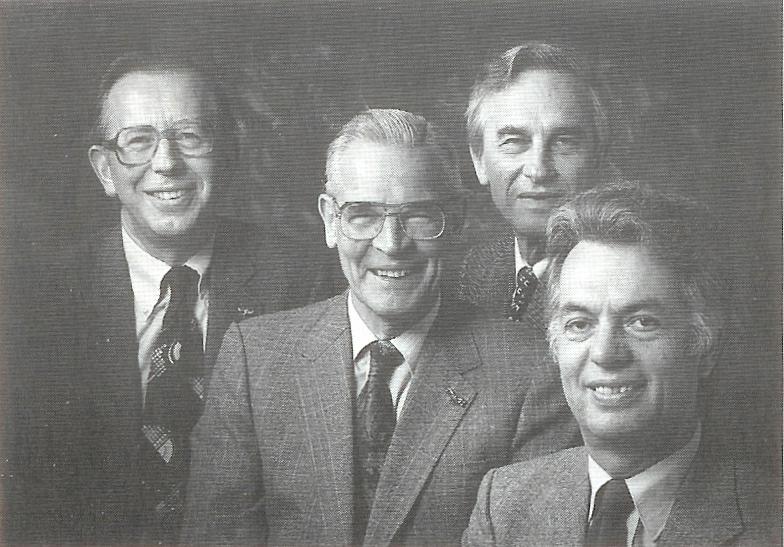
It is with deep sadness that we announce the death of Agienus Vrij, who passed away on 3 January 2019.
Agienus was born in Utrecht in 1932. He started his study of chemistry/physics with mathematics in 1949 at Utrecht University, where he obtained his “Kandidaatsexamen” (BSc) in 1953. Thereafter, he chose the lab of Professor Overbeek to specialise in physical chemistry and colloid science and completed his MSc study in 1956. Subsequently, he started to work on his dissertation on light scattering of charged particles at the Van ‘t Hoff laboratory, under the guidance of Professor Theo Overbeek. In his PhD thesis, which he successfully defended in 1959, he demonstrates his characteristic scientific skill: combining deep theoretical insights with a formidable intuition of what can be achieved experimentally.
After military service for two years he returned to the Overbeek lab and started to work on scattering from thin soap lamellae. Then he moved to Stanford in the USA and worked as postdoctoral fellow with Professor Paul J. Flory during the academic year 1962-1963. With Flory he worked on a model for the thermodynamic properties of linear alkane liquids. Together with PhD student Robert Orwoll, who finished the work after Agienus Vrij returned to the Netherlands, they published the now classical papers on the Flory-Orwoll-Vrij (FOV) theory.
After returning to Utrecht, Agienus became associate professor in 1966 and full professor in 1968. He continued to collaborate with Overbeek, for instance on the influence of polymers on colloidal dispersions and again started to work on the experimentally demanding and challenging area of thin liquid films and their fluctuations. In 1971-1972, Agienus was a visiting professor at the Massachusetts Institute of Technology, Department of Chemical Engineering. In the 1970s Agienus became fascinated by demixing of different polymers in a common solvent and the interfacial tension between the demixed phases. Agienus Vrij was the first to apply the ideas of van der Waals and Cahn & Hilliard to arrive at the concentration profiles between the coexisting phases of these polymer solutions.
In Agienus Vrij’s view there is a gradual transition between colloids and polymers, with star polymers, dendrimers and polymer grafted colloids as intermediates. This inspired him to study colloid-polymer mixtures. In 1976 he wrote another seminal paper in which he derived the depletion interaction for mixtures of hard spheres plus penetrable hard spheres (or ghost spheres) and, as was realized later, independently re-derived the almost forgotten Asakura-Oosawa result. This work by Vrij received increasing attention, also due to systematic experimental work by Professor Brian Vincent and others in the UK and Professor Bill Russel and co-workers in the USA.
At the end of the 1970s Agienus Vrij started to focus on model colloids and their behaviour beyond the dilute concentration regime, a theme that became his main focal point until his retirement. Vrij was inspired by J. Perrin’s colloid-atom analogy and realised that colloidal dispersions can be viewed as supramolecular fluids. The simplest model for which physicists had derived liquid-state theory results is the hard sphere dispersion. Agienus Vrij, together with his senior staff members Harry Fijnaut, Kees de Kruif, and his PhD students, used latex particles to mimic such hard sphere systems and started to develop well-defined silica particle systems. Using light and X-ray scattering techniques they measured static and dynamic properties of such dispersions and demonstrated the applicability of liquid-state theory to colloidal fluids. Courageously, Agienus Vrij and Kees de Kruif initiated early, now classical, small-angle neutron scattering studies in Grenoble on their hard-sphere-like silica particles as well as on silica particles with tuneable stickiness or with screened double layer repulsions. With Russel and co-workers and the rheology group of Jorrit Mellema (University of Twente) they made early classical studies on the rheology of (adhesive) hard sphere dispersions.
In 1990 he was rewarded with the Royal Shell prize for his entire scientific oeuvre. He made seminal contributions, guided many PhD students and worked with, besides the strong scientists mentioned, highly talented PhD students. Agienus was a modest person, an inspiring teacher and collaborator for many, and an active member of the colloid community. He was always eager to learn something new, and in following his scientific curiosity he focused on conten – and disregarded hyperbole.
Agienus Vrij took early retirement in 1993. Since then, at a tempo he found pleasant, he kept working on scientific topics he liked which included the interfacial tension of a demixed colloid-polymer mixture, the static scattering properties of multi-component mixtures and the Donnan potential in relation to electrical double-layer interactions. Also he wrote an extensive book chapter in Hans Lyklema’s “Fundamentals of Colloid and Interface Science” series in which he summarised major parts of his work on concentrated colloidal dispersions.
Until autumn 2018 one could regularly meet him at the Van `t Hoff laboratory in Utrecht, his scientific home. One could always have an interesting conversation with him. It was clear that he was continuously following recent developments, in a critical but also open and curious manner. His views remained profound and lucid until the end, as illustrated by the considerate comments he made on the proofs of the last paper1 to which he contributed.
Agienus leaves behind his wife Ans, with whom he was married for 61 years, three children and five grandchildren. He will be sadly missed.
Albert P. Philipse
Henk N.W. Lekkerkerker
Gert Jan Vroege
Remco Tuinier
1: Mark Vis, Remco Tuinier, Bonny Kuipers, Agienus Vrij and Albert Philipse, Interactions between amphoteric surfaces with strongly overlapping double layers, Soft Matter 14 (2018) 4702-4710.
